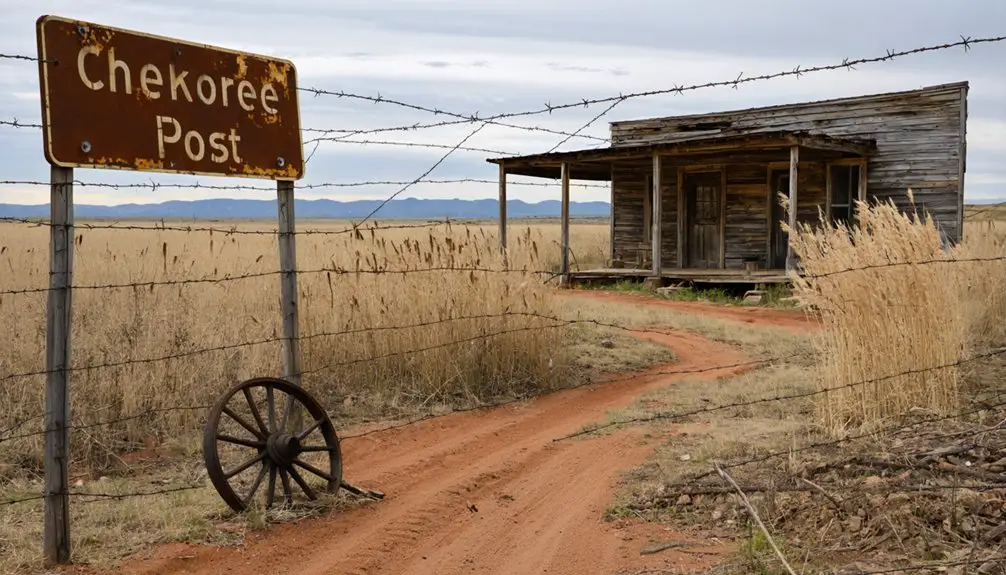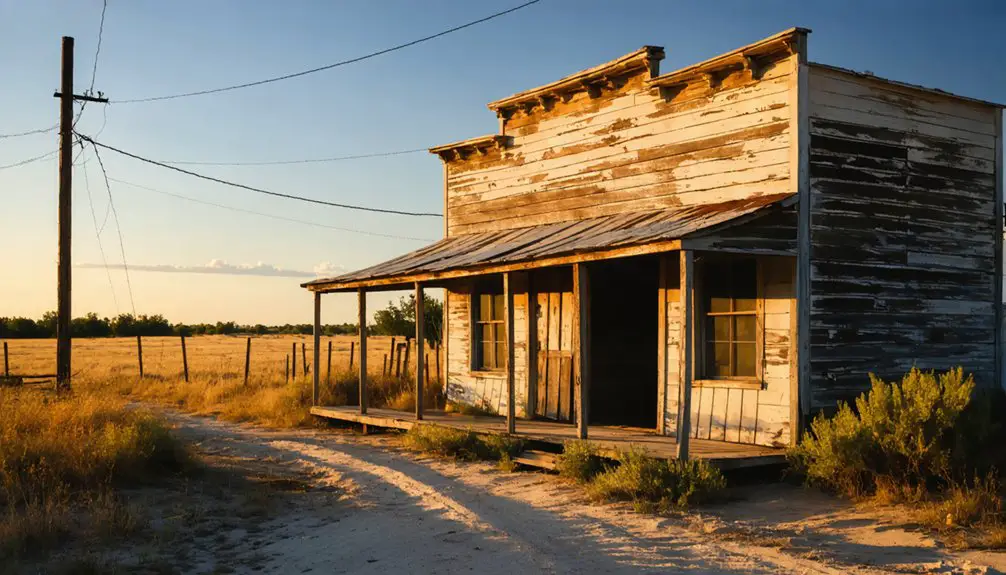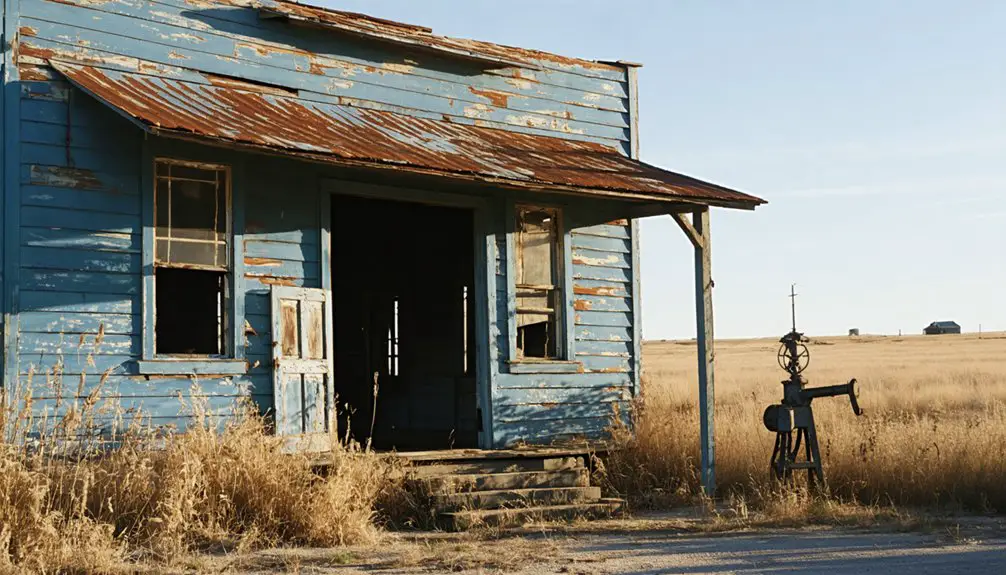You’ll find Chism’s origins in the 1847 Chisholm Springs Trading Post, established by Cherokee trader Jesse Chisholm near present-day Asher, Oklahoma Territory. The bustling frontier outpost featured a store, blacksmith shop, and warehouse cabin for furs, serving as an essential supply point during the 1849 Gold Rush. Chisholm’s multilingual skills and diplomatic prowess made the settlement a significant hub for Native American-settler commerce. The site’s rich history holds fascinating tales of cultural exchange and economic transformation.
Key Takeaways
- Chism, Oklahoma began as Chisholm Springs Trading Post in 1847, established by Jesse Chisholm near present-day Asher.
- The trading post included essential frontier facilities like a store, blacksmith shop, warehouse cabin, and protective stockade.
- The settlement’s strategic location along trade routes made it a crucial supply point during the 1849 California Gold Rush.
- After the decline of frontier trade and cattle drives, the once-bustling trading post gradually faded into a ghost town.
- The site’s historical significance stems from its role in facilitating commerce between Native American tribes and western settlers.
Origins of Chisholm Springs Trading Post
While French-American traders from the Chouteau family initially established three trading posts along the Canadian River in 1835, Jesse Chisholm founded his own significant outpost in 1847 about two miles east of present-day Asher, Oklahoma Territory.
The trading post’s significance grew as it became a crucial supply point during the 1849 Gold Rush.
You’ll find that Chisholm’s establishment included essential structures: a store, blacksmith shop, warehouse cabin for furs, and a tall stockade built by Col. Auguste Pierre Chouteau.
The post’s multicultural interactions flourished as Plains Indians traded hides while settlers and gold seekers stopped for provisions. Known as Prairie Jess among Native Americans, Chisholm earned respect as a skilled interpreter and peacemaker in the region.
His remarkable ability to communicate in fourteen Indian dialects helped facilitate smooth trading operations at the post.
Chisholm’s strategic location near the western edge of Indian Territory made it the last major trading hub before New Mexico, cementing its importance in frontier commerce and cultural exchange.
Jesse Chisholm: The Man Behind the Settlement
You’ll find Jesse Chisholm’s remarkable legacy woven into this settlement’s history as a Cherokee merchant who mastered fourteen Native American languages and built a network of trading posts across Indian Territory.
Born to a Cherokee mother Martha Rogers, Chisholm grew up deeply immersed in Native American traditions that would shape his future role as a cultural bridge-builder.
Through his work as an interpreter and diplomat, he bridged cultural divides between Plains tribes and settlers while establishing essential trading routes that would later become the famous cattle trail bearing his name.
His trading operations and peace-making efforts left an indelible mark on the region until his death in 1868, shaping both commerce and cross-cultural relations in early Oklahoma Territory. His close relationship with Montford T. Johnson led to successful ranching ventures that transformed the agricultural landscape of Indian Territory.
Prairie Trading Pioneer
Born in Tennessee’s Hiwassee region around 1805, Jesse Chisholm emerged as one of the most influential figures in Oklahoma’s early development. His trading techniques revolutionized commerce across Indian Territory, as he established crucial trading posts near Wichita, Oklahoma City, and throughout the region. His role as interpreter at numerous treaty councils between native tribes and government officials proved invaluable.
You’ll find his legacy in the pioneering spirit that drove him to overcome frontier challenges while building relationships with Plains tribes through his remarkable command of 14 Native languages.
As a Scottish-Cherokee entrepreneur, Chisholm mastered the art of transporting goods via wagon trains to remote Indian villages and Army posts. His strategic network of trading posts served as essential hubs where Native Americans and settlers could exchange goods and cultural understanding, making him an indispensable bridge between worlds in the expanding American West. His vital contributions to diplomacy were demonstrated when he assisted the Grand Council at Salt Plains in 1853, fostering peace among Plains tribes.
Cross-Cultural Peace Ambassador
Jesse Chisholm’s trading prowess laid the foundation for his remarkable role as a cross-cultural peace ambassador in Indian Territory.
You’ll find his cultural diplomacy reflected in his mastery of over 13 Native American languages plus Spanish, enabling unprecedented indigenous dialogue across tribal boundaries. He gained rare access to traditionally closed Comanche and Kiowa lodges, becoming the first outsider trader granted permanent entry. Growing up in the old Cherokee Nation, he developed a deep understanding of tribal traditions and values.
Through his unique position, he served as interpreter at pivotal events like the Grand Council of 1853, facilitating peace among warring tribes.
During the Civil War, he maintained neutrality to protect tribal communities and led refugees to safety. His work negotiating with Plains tribes, the Republic of Texas, and the U.S. government from 1838 to 1858 established lasting peaceful relations in a volatile region. His reputation for honesty and wisdom made him an invaluable mediator in treaty negotiations throughout the frontier.
Cherokee Merchant Legacy
While many frontier traders left their mark on the American West, few shaped the region’s commerce as profoundly as the Cherokee merchant Jesse Chisholm. Born to a Scottish father and Cherokee mother, his unique heritage positioned him perfectly for frontier commerce.
You’ll find his entrepreneurial spirit reflected in the strategic placement of trading posts, including the essential Chisholm Springs near present-day Holdenville, Oklahoma. His mastery of 14 Native American languages made him an unparalleled force in Cherokee entrepreneurship, enabling trade across diverse tribal territories.
The routes he established, particularly the famous Chisholm Trail, revolutionized regional commerce. His trading empire stretched from Indian Territory to Texas, serving as a significant link between Native American traders and expanding western markets during the pivotal Gold Rush era. Recognized for his exceptional character, he was never robbed or harmed throughout his trading career.
Daily Life at the Frontier Trading Hub
Three essential hubs of commerce and culture emerged at frontier trading posts across Indian Territory in the mid-1800s, including strategic locations near present-day Oklahoma City, Cleveland County, and Wichita, Kansas.
At these posts, you’d witness daily cultural exchanges between settlers, Plains Indians, and military personnel, all maneuvering complex social hierarchies through trusted interpreters and guides.
You’d find wagon trains arriving with manufactured goods like cloth, metal tools, and firearms, trading for Native American furs and horses.
Frontier challenges shaped every aspect of daily operations – from securing safe passage through tribal territories to adapting to seasonal weather patterns. Jesse Chisholm’s experience guiding parties since 1836 made him invaluable in navigating these challenges.
You’d see traders using multiple Native dialects to conduct business, fostering trust and neutrality while serving as informal community centers for news exchange and conflict mediation.
Native American Relations and Commerce

Through his exceptional fluency in over a dozen Native American languages, half-Cherokee trader Jesse Chisholm established himself as an indispensable mediator between tribes and settlers in Indian Territory.
His influence on intertribal diplomacy and commerce exchange shaped the region’s development, creating lasting impacts on Native American relations.
Jesse Chisholm’s diplomatic prowess and trading network transformed Native American interactions, leaving an enduring legacy on tribal relationships in Indian Territory.
- Operated strategic trading posts that served as commercial hubs for multiple tribes, fostering peaceful interactions through trade.
- Mediated vital peace agreements between warring tribes, including the Comanches, Wichitas, and Kiowas.
- Facilitated commerce exchange of essential goods, from horses and furs to manufactured items along the Arkansas River route.
- Negotiated treaties between Plains tribes and U.S. authorities, while helping rescue and integrate captive children into his family.
These activities established a foundation for stable Native-settler relations during a period of significant territorial change.
The California Road Connection
Beyond Jesse Chisholm’s influence on Native American trade networks, the California Road carved its own significant path through Indian Territory.
You’ll find that this essential emigrant route, established during the 1849 gold rush, brought an estimated 20,000 travelers through the region in that year alone. The road followed the Canadian River’s course, connecting Fort Smith and Van Buren, Arkansas, to the western gold fields.
Near Chism, the California Road’s presence shaped local development as trading posts and supply stations emerged to serve the steady stream of westward travelers.
The route’s established pathways later influenced the development of the Chisholm Trail, creating a lasting impact on regional travel patterns.
You can still trace this historic road’s legacy in modern Oklahoma’s highway system and commemorative markers.
Legacy of the Chisholm Trail

You’ll find the Chisholm Trail‘s impact on Chism deeply intertwined with the massive cattle drives that moved millions of longhorns north to Kansas railheads.
The trail served as an essential trading route, with an estimated six million cattle traversing its 800-mile length from Texas through Oklahoma to Kansas between the 1860s and 1880s.
Your understanding of Chism’s historical significance wouldn’t be complete without recognizing how the trail’s economic influence shaped the region, as cattle drives typically moved 2,500 to 3,000 head at a time, creating bustling commerce at strategic points along the route.
Cattle Drives to Kansas
During the peak of cattle drives from 1866 to 1884, an estimated 5 to 6 million head of Texas cattle traversed the Chisholm Trail to reach Kansas railheads.
You’d find massive herds stretching 2-3 miles long, with seasoned trail bosses managing the complex cattle drive logistics.
Here’s what you needed to move a typical herd north:
- A crew of 10-14 cowboys to keep cattle moving and prevent stampedes
- A cook with chuck wagon to feed the hungry crew
- A horse wrangler managing 100-150 horses
- A skilled trail boss planning routes and water stops
The trail boss’s responsibilities included strategic planning of the 800-mile journey, ensuring the herd moved about 10 miles daily while hitting essential watering points.
You’d find the drives culminating at booming Kansas cattle towns like Abilene, where stockyards awaited.
Trading Route Impact
While the Chisholm Trail primarily served as a cattle drive route, its legacy as a trading corridor transformed the economic and cultural landscape of Indian Territory.
You’ll find that trading post dynamics centered around Jesse Chisholm’s strategic outposts, which became essential hubs for commerce between Native Americans, settlers, and cattle drivers. These posts weren’t just stopping points; they shaped the region’s development patterns and future town locations.
The trail’s cattle drive logistics created a complex network of economic relationships.
When you consider Black Beaver’s influence as a Delaware scout and Chisholm’s role as a trader, you’ll see how their efforts connected Texas ranchers with Kansas railheads while fostering trade relationships with local tribes.
This network revolutionized commerce across Indian Territory, integrating the region into broader economic systems.
Economic Impact on Indian Territory
The economic influence of Indian Territory’s tribal nations created a powerful engine of growth, generating approximately $12.9 billion in goods and services across Oklahoma.
You’ll find tribal economies flourished through diverse market dynamics, with nations like Cherokee and Choctaw leading substantial development.
Here’s how tribal nations transformed the territory’s economy:
- Choctaw Nation contributed $2.51 billion and created 12,000 jobs, with Durant seeing 4,200 positions.
- Cherokee Nation generated $3 billion annually while supporting 19,000 jobs statewide.
- Tribes collected strategic cattle taxes, ranging from 16 to 40 cents per head.
- Combined tribal activities provided $4.6 billion in wages and benefits to Oklahoma workers.
These economic powerhouses funded critical infrastructure, including water systems, roads, and emergency services, while maintaining stable employment through uncertain times.
From Trading Post to Ghost Town

As one of three trading posts established along the Canadian River, Chisholm Springs emerged in 1835 under Col. Auguste Pierre Chouteau, featuring a blacksmith shop, fur warehouse, and stockade enclosure.
When Jesse Chisholm arrived in 1847, you’d have found a bustling trading center serving nearby Indian families and California Gold Rush travelers.
The ghost town dynamics began taking shape after Chisholm’s death in 1868.
You’ll notice how shifting trade routes, the rise of Kansas railheads, and evolving cattle drives diminished the post’s significance.
Without a post office and with dwindling population, Chisholm Springs couldn’t sustain itself.
This piece of Chisholm history transformed from a crucial supply hub into an abandoned settlement, marking the end of an era when trading posts were essential lifelines for both Native Americans and westward travelers.
Frequently Asked Questions
What Happened to Jesse Chisholm’s Original Trading Post Building?
You’d expect Jesse Chisholm’s trading post to stand proudly today, but it’s disappeared entirely – no preserved structures remain from his original building at Chisholm Springs, likely lost to time and weather.
Were There Any Major Conflicts or Attacks at Chisholm Springs?
You won’t find any documented major conflicts or attack incidents at Chisholm Springs. While Civil War violence erupted nearby in Indian Territory, the trading post remained peaceful under Jesse Chisholm’s diplomatic influence.
What Specific Goods Were Most Commonly Traded at Chisholm Springs?
You’d find the usual frontier fare: fur pelts, blacksmith services, basic provisions for travelers, and trade goods like cloth and metal wares – everything needed along those bustling supply routes.
How Many People Lived in Chisholm Springs During Its Peak?
You can’t determine Chisholm Spring’s exact peak population dynamics, as no formal census records exist. During its peak years before 1862, the trading post hosted a transient mix of traders and Plains Indians.
Did Any Famous Outlaws or Lawmen Ever Visit Chisholm Springs?
Despite Jesse Chisholm’s extensive trading network spanning hundreds of miles, you won’t find records of infamous outlaws or legendary lawmen visiting Chisholm Springs. It remained focused on peaceful commerce and tribal relations.
References
- https://sites.rootsweb.com/~okpcgc/towns/chisholm_springs.html
- https://www.okhistory.org/publications/enc/entry?entry=CH045
- http://blogoklahoma.us/place/473/blaine/jesse-chisholm
- https://www.legendsofamerica.com/we-jessechisholm/
- https://www.hmdb.org/m.asp?m=11604
- https://sites.rootsweb.com/~okpcgc/people_and_families/j_chisholm.html
- https://en.wikipedia.org/wiki/Chisholm_Spring
- https://en.wikipedia.org/wiki/Jesse_Chisholm
- https://www.chickasawfilmsource.com/Home/Entries/People/Jesse-Chisholm.aspx
- https://www.tshaonline.org/handbook/entries/chisholm-jesse



